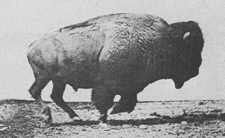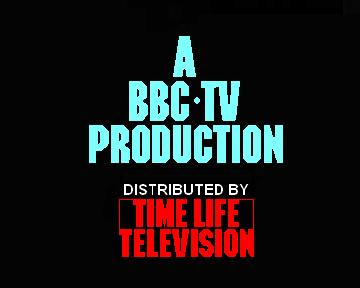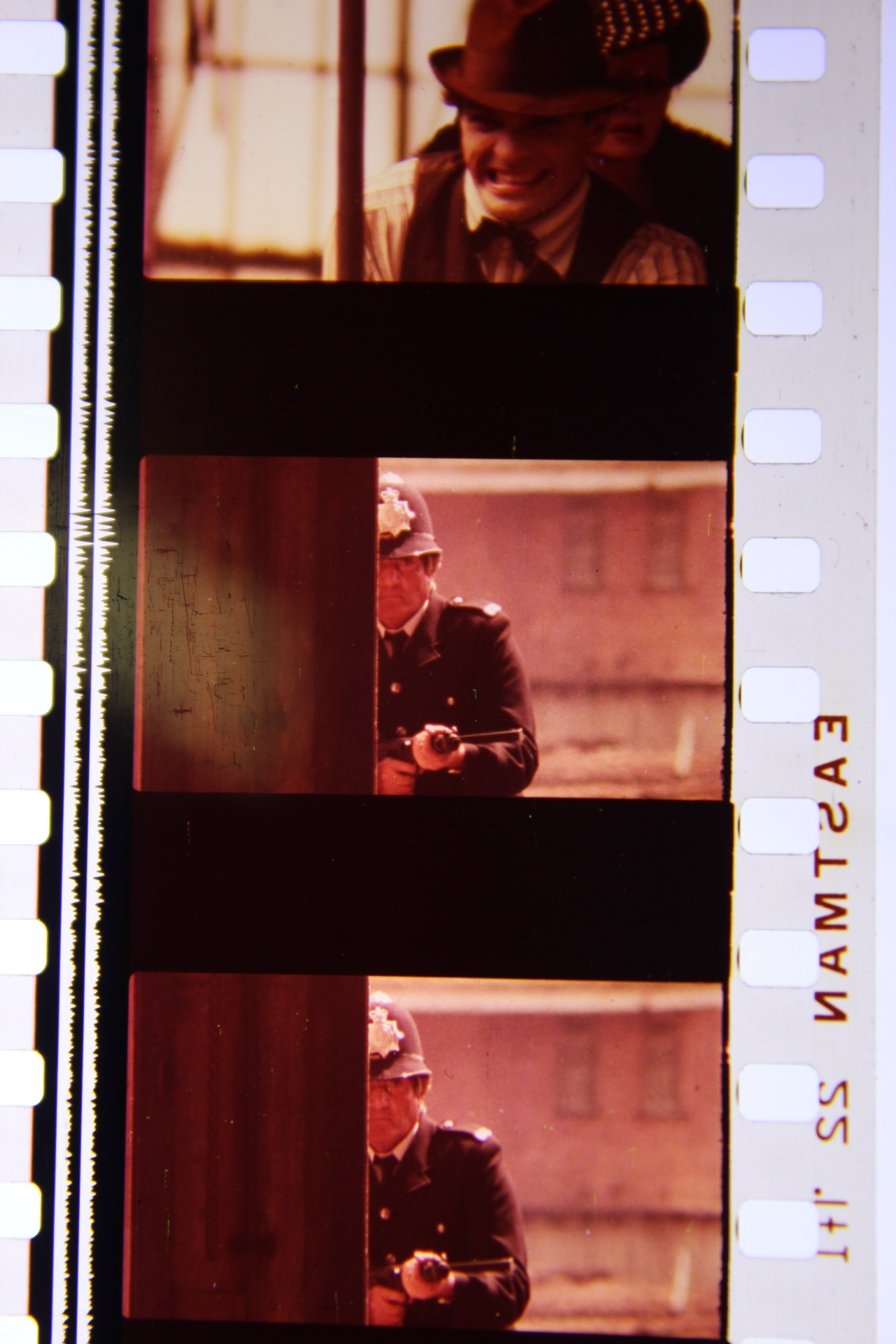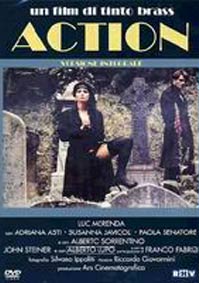THE WORKS OF TINTO BRASS
Action
(1979)
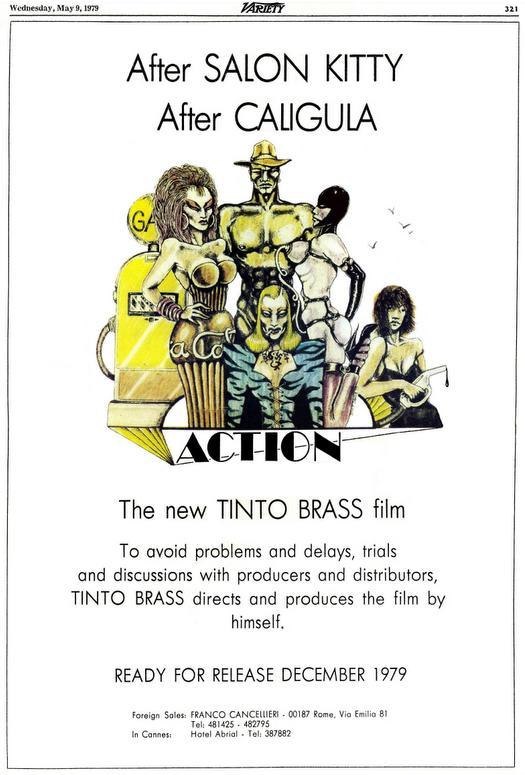
The above poster art is by The Phenomenal Jost Jakob |
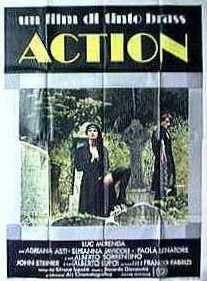 |
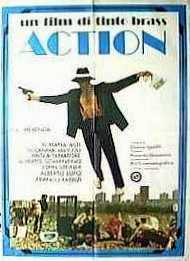 |
The protracted lawsuits involving
Caligula made Brass unemployable. In order to
rescue his reputation, he paid for his next production
himself. He moved his crew to England and made this
16mm movie about an actor, Bruno (Luc Merenda), who
specializes in gangster rôles in cheap action dramas.
He is fired for cutting up on Tinto Brass’s set
and ruining a take, and so follows his agent’s
advice by taking a job with a porno production, which
puts even further strain on his already strained
marriage. Before he has a chance to act in a scene, he
rescues Doris, an abused would-be Shakespearean actress
who prefers to call herself Ophelia, from the set. Together they set forth
on a journey through England, where they are attacked
in a junkyard by punks, are taken in by an escaped
lunatic who thinks he’s Garibaldi, and are
incarcerated in an insane asylum where the delicate
and emotionally unstable Ophelia commits suicide. An
escape from the asylum is easy, and Bruno and
Garibaldi steal a car, rob a cash register, shoot a
cop, get a job pumping gas at a petrol station in the
middle of nowhere, and find themselves caught in the
middle of a domestic feud. This magnificent surreal
work proves what we have suspected all along, namely,
that the national language of England is Italian. The
film was a family affair, as Brass’s wife Carla
“Tinta” Cipriani was production secretary,
their daughter Beatrice was continuity girl and played
two rôles (continuity girl on the set at the beginning
and the girl in the garbage dump who won’t wear
her cast), and their son Bonifacio was still
photographer. A lot of fun! Too bad it flopped.
There is a much-longer version on DVD in Italy,
poorly derived from Tinto Brass’s personal print, and it has
significantly more dialogue. Surprisingly, it was not the nudity
that was cut from the release version.
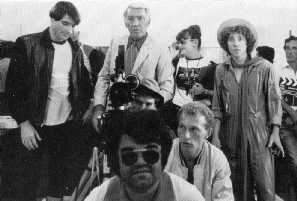 |
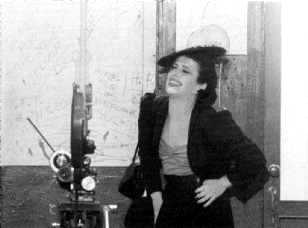 |
| On the set of a porn film |
Ophelia is unhappy with her rôle |
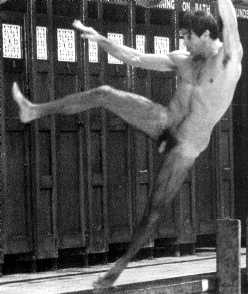 |
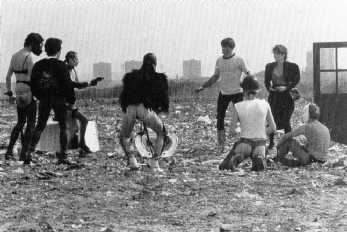 |
| Horsing around in the pool |
The punks are not amused |
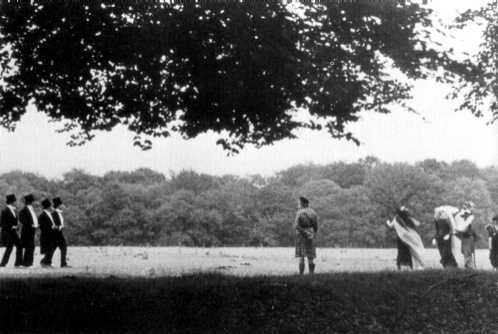 |
Bruno’s vision in the woods |
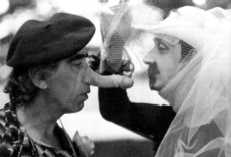 |
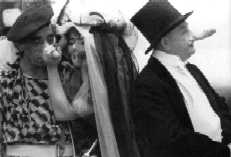 |
| No need for explanation |
Horsing around on the set |
A NOTE AND A QUESTION: Brass
dubs an extra’s line: “Cosa sei, un
prete?” Who dubbed
Osiride Pevarello?
THE END OF PHASE ONE: This was the only
time that Brass collaborated with both of his favorite writers,
Giancarlo
Fusco and Roberto
Lerici, and it was his last collaboration with Fusco. Never again
would Brass’s films have the same raw forcefulness and earthy
feel that he achieved with these two artists. Never again would his
films look so organically grown, almost improvised. Yes, he would
achieve greatness again, but not this sort of greatness. I
really miss this old style. It puts one in mind of the great comics
of the teens and twenties, who felt free enough, creative enough, and
confident enough to let films take on lives of their own. Pier Paolo
Pasolini also had that gift. Dusan Makavejev, in WR: Mysteries of the Organism
(1971) and Sweet Movie (1974) worked the same magic. But who
else? I know of no one. Action not only brought to a close
the most vibrant phase of Brass’s career; it also brought to a
close an entire era.
Here’s something interesting: a few frames from a 35mm release print.
So that settles some arguments. The original release prints were 1:1.85. So there.
The movie had been shot in standard 16mm, and for the blowup the top and bottom of the image were blacked out.
The VHS in my collection was something closer to 1:1.66, but with the sides lopped off.
The VHS revealed something: the black borders at the top and bottom were not entirely black.
They contained the faintest vestige of an image that the lab had cropped off from the original 16mm.
|
The DVD, about 10 minutes longer than the VHS version.
Too much compression, I mean, way too much compression.
Yet a friend who is a video engineer tells me that it is easy to make a computer adjustment and to bring in all the image information.
He says that there is no image compression at all. All the info is there, it just requires some twiddling to bring it all out.
And the sound is about one syllable behind the picture all the way through.
But it’s got optional Italian captions and optional English subtitles and a nice photogallery
and an excerpt from Lorenzo Codelli’s unreleased feature-length interview with Tinto Brass (conducted in 2003),
it’s still mesmerizing and hilarious and delightful and unique and quirky and memorable and just so absolutely lovely
and a million times better than most other movies. |
Tinto Brass presenta
Action
CIDIF: Consorzio Italiano Distributori Indipendenti Film
| Direttore della fotografia (director of photography) |
Silvano Ippoliti |
| Scenografo (production design) |
Claudio Cinini |
| Costumi (costumes) |
Jost Jakob |
Sceneggiatura e dialoghi
(script and dialogue) |
Giancarlo Fusco, Roberto Lerici,
Tinto Brass |
| Musiche (music) |
Riccardo Giovannini |
| eseguite da (performed by) |
Blue Malbec Band |
| Edizioni musicali (music publisher) |
April Music |
| Musiche di repertorio (musical excerpts) |
HOW I WAS NICE
cantata da Hiliry Harvey
COME VEDI
cantata da Gianna Giovannini
BRAVO POUR LE CLOWN
cantata da Edith Piaf |
| Operatore alla macchina (camera operator) |
Enrico Sasso |
| Assistente operatore (focus puller) |
Luigi Conversi |
| Segretaria di edizione (continuity) |
Bea Brass |
| Aiuto registi (assistant directors) |
Fabrizio Pisaneschi, Massimo Spano, Francesco Favino |
| Aiuto montatrice (assistant editor) |
Fiorenza Mueller |
| Assistenti montatori (second assistant editors) |
Claudio Maimone, Giovanna Ritter |
| Fotografi di scena (still photographers) |
Gianfranco Salis, Boni Brass |
| Ufficio stampa (publicity) |
Maria Ruhle |
| Coreografo (choreographer) |
Giuseppe “Pino” Pennese |
| Fonico (sound) |
Pietro Spadoni |
| Microfonista (boom operator) |
Flavio Leone |
| Truccatore (make-up) |
Pino Capogrosso |
| Parrucchiera (hairdresser) |
Jole Cecchini |
| Sarte (dressmakers) |
Anna Cirilli, Sally Sekers |
| Art works by |
Robert Knight |
| from |
Nicholas Treadwell Gallery |
| English graffiti |
Carla Volpato |
| Hair stylist |
Natalino |
| Direttore di produzione (production manager) |
Mario di Biase |
Organizzazione generale
(production management) |
Carla Cipriani, Vincenzo Maria Siniscalchi |
Soggetto, regia, montaggio
(story, direction, editing) |
Tinto Brass |
| Capo macchinista (key grip) |
Quirino Fantauzzi |
| Macchinisti (grips) |
Orlando Zuccari, Osvaldo Giansanti |
| Capo elettricista (gaffer) |
Sergio Spila |
| Elettricisti (best boys) |
Marcello Cardarelli, Giuseppe Fabrizi |
| Amministratore (administrator) |
Mario Ficini |
| Ispettori di produzione (unit managers) |
Vittorio Fornasiero, Marcello Bollero |
| Segretari di produzione (production secretaries) |
Rossella Ferrero, Franco di Tivoli |
| Location managers |
Massimiliano Bramucci, Alan Sekers |
| Direttore di produzione per le riprese in teatro |
Enzo Nigro |
| Teatri (studio) |
Dear |
| Suono (sound studio) |
Cinecittà |
| Effetti speciali sonori (special sound effects) |
Alvaro Gramigna, Fernando Caso |
| Missaggio (sound mixer) |
Fausto Ancillai |
| Pellicola (negative) |
Eastmancolor |
| Sviluppo e stampa (laboratory) |
Telecolor |
| Una produzione (produced by) |
Ars (Attori Registi Solidali) Cinematografica |
| Presentata da (presented by) |
Franco Cancellieri |
| PERSONAGGI E INTERPRETI |
|
| Bruno Martel |
Luc Merenda |
| Florence |
Adriana Asti |
| Doris/Ophelia |
Susanna Javicoli |
| Ann Shimpton |
Paola Senatore |
| Garibaldi |
Alberto Sorrentino |
Woodruff Vandenberg Scott,
“The Big Woody” |
Gianfranco Bullo |
| Il omosessuale |
Giancarlo Badessi |
| Agent |
John Steiner |
| ??? |
Edoardo Florio |
| ??? |
Luciano Crovato |
| Joe |
Alberto Lupo |
| ??? |
Paola Montenero |
| ??? |
Alina de Simone |
| Il produttore |
Franco Fabrizi |
| Herself / Girl with Broken Leg |
Beatrice Brass |
| ??? |
Helene Chauvin |
| ??? |
Gigi d’Ecclesia |
| King Kong |
Eolo Capritti |
| Un arrestato |
Osiride Pevarello [uncredited] |
| Angry Dog |
Tinto Brass [uncredited] |
|
